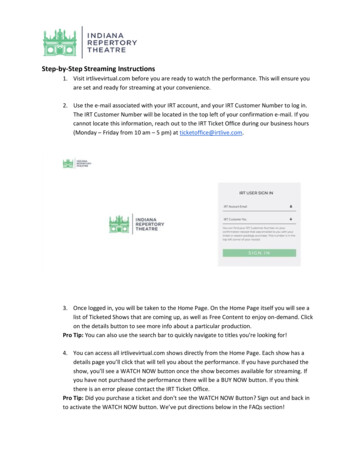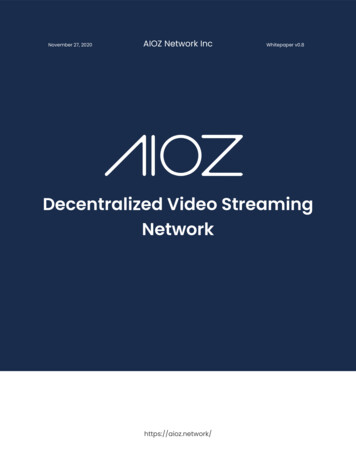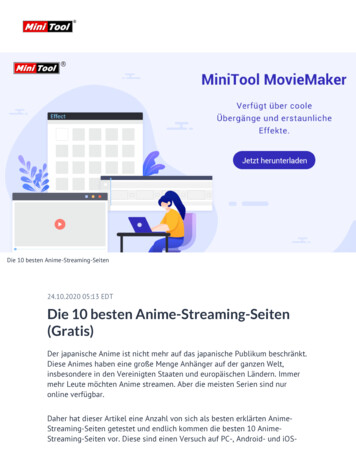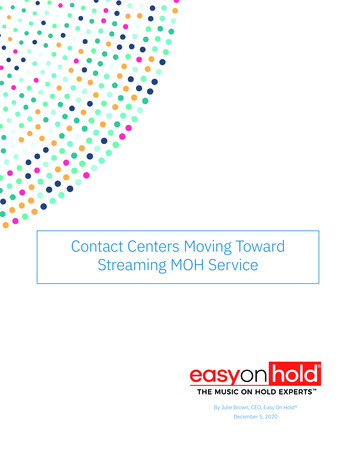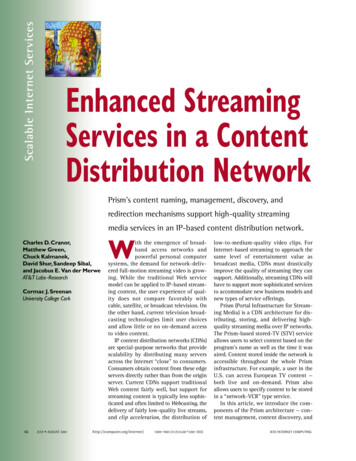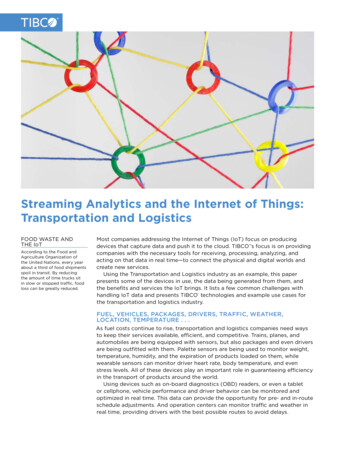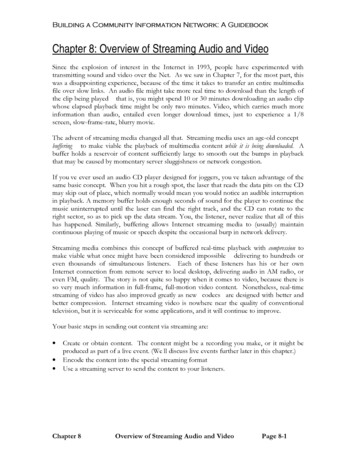
Transcription
Building a Community Information Network: A GuidebookChapter 8: Overview of Streaming Audio and VideoSince the explosion of interest in the Internet in 1993, people have experimented withtransmitting sound and video over the Net. As we saw in Chapter 7, for the most part, thiswas a disappointing experience, because of the time it takes to transfer an entire multimediafile over slow links. An audio file might take more real time to download than the length ofthe clip being played – that is, you might spend 10 or 30 minutes downloading an audio clipwhose elapsed playback time might be only two minutes. Video, which carries much moreinformation than audio, entailed even longer download times, just to experience a 1/8screen, slow-frame-rate, blurry movie.The advent of streaming media changed all that. Streaming media uses an age-old concept –buffering – to make viable the playback of multimedia content while it is being downloaded. Abuffer holds a reservoir of content sufficiently large to smooth out the bumps in playbackthat may be caused by momentary server sluggishness or network congestion.If you’ve ever used an audio CD player designed for joggers, you’ve taken advantage of thesame basic concept. When you hit a rough spot, the laser that reads the data pits on the CDmay skip out of place, which normally would mean you would notice an audible interruptionin playback. A memory buffer holds enough seconds of sound for the player to continue themusic uninterrupted until the laser can find the right track, and the CD can rotate to theright sector, so as to pick up the data stream. You, the listener, never realize that all of thishas happened. Similarly, buffering allows Internet streaming media to (usually) maintaincontinuous playing of music or speech despite the occasional burp in network delivery.Streaming media combines this concept of buffered real-time playback with compression tomake viable what once might have been considered impossible – delivering to hundreds oreven thousands of simultaneous listeners. Each of these listeners has his or her ownInternet connection from remote server to local desktop, delivering audio in AM radio, oreven FM, quality. The story is not quite so happy when it comes to video, because there isso very much information in full-frame, full-motion video content. Nonetheless, real-timestreaming of video has also improved greatly as new “codecs” are designed with better andbetter compression. Internet streaming video is nowhere near the quality of conventionaltelevision, but it is serviceable for some applications, and it will continue to improve.Your basic steps in sending out content via streaming are: Create or obtain content. The content might be a recording you make, or it might beproduced as part of a live event. (We’ll discuss live events further later in this chapter.)Encode the content into the special streaming formatUse a streaming server to send the content to your listeners.Chapter 8Overview of Streaming Audio and VideoPage 8-1
Building a Community Information Network: A GuidebookThe following diagram depicts these basic concepts:Streaming Media ConceptsOh say can you see?By the dawn’s early light.What so proudly we hailed.Encoded audio/video fileBy the dawn’searly light.Content rThe InternetOh say canyou see?User’s Browserwith StreamingPlayer PluginHere, we’ve encoded an audio rendition of the Star Spangled Banner. Playback occurs in thisfashion: After it was digitized, the entire audio file was placed on a streaming server to awaitrequests for playback. A streaming server is simply a server that has speacializedstreaming software installed – for instance, the Real System Server from Real Networks,Inc. The content has been specially encoded and placed into a file in the streamingserver’s file hierarchy.The server waits for a request from the user for a particular streaming document. Whena user clicks on the URL for such a document, the user’s browser sends a request to thestreaming server.The streaming server finds the relevant content and prepares to send the file over theInternet. As the file transmission begins, the contents are broken into “packets;” eachpacket is sent as soon as it is prepared.The user’s browser has had a streaming media plugin installed, such as the Real Player.The plugin places each packet into its buffer as it arrives, and, when the buffer issufficiently full, the plugin starts playing the content.Further packets continue to arrive. Thus, the buffer is being filled and emptiedsimultaneously, as playback continues – usually uninterrupted.In the event of severe network congestion, playback may pause. In this case, the playerthe user will experience a pause in the playback while the player attempts to refill thebuffer.Chapter 8Overview of Streaming Audio and VideoPage 8-2
Building a Community Information Network: A GuidebookVendors of Streaming SolutionsThere is one dominant vendor of streaming technology, with other players on the horizon: Real Networks Inc is the pioneer in streaming technology, and continues with 90% ofmarket share as of this writing. Formerly Progressive Networks, Real created firstRealAudio, then RealVideo, formats, and now markets the RealSystem with these andother formats.Apple was a pioneer in non-streaming digital video on personal computers with itsQuickTime format. With the release of QuickTime version 4 in 1999, Apple begantouting QuickTime as a streaming format.Microsoft, once a partner with Real Networks, is now advocating its own streamingarchitecture and its own products such as NetShow and NetMeeting.As of this writing, your choice of which technology to embrace will be fairly basic: If youselect the RealSystem, you will use the format that is most likely to have players installed onyour user’s desktops. This is because Real Networks was the only streaming media vendorto succeed in getting its plugin bundled with browsers and with the Windows 98 operatingsystem. If you choose another system, your users are more likely to have to install a playerplugin before they can play back your content. Thus, you may want to select Real, unlessyou see features in competing systems that offer a compelling advantage unique to yourcontent. Over time, Microsoft and Apple – and perhaps new contenders – may well breakthe dominance Real has as of this writing.The rest of this chapter will give an overview of the Real System tools and techniques. Thegeneral concepts will apply to other systems. Real Networks provides excellent, thoroughdocumentation, which you will want to consult and read in detail when you’re ready tolaunch a project. In particular, look for these two manuals at www.real.com: RealSystem G2 Production GuideRealServer Administration GuideEach of these manuals is over 200 pages in length. They are offered in Adobe Acrobatformat. You will probably want to print the content and place it in a binder for offlinereading.Note that the Real software has evolved dramatically over time. During this rapid evolution,content providers and users of the Real System have experienced frustrating compatibilityproblems. With Real System G2, these problems have largely been ameliorated, and thesystem has reached a reasonable level of maturity.RealSystem Media TypesThe RealSystem offers several media types:Chapter 8Overview of Streaming Audio and VideoPage 8-3
Building a Community Information Network: A Guidebook Audio: Suitable for speeches, oral history, and music delivery. Quality can besurprisingly good even over a 28.8 kilobit/second modem.Video: Video with audio in synchronization. High-quality video requires a tremendousamount of bandwidth, so over dialup modems or even over faster links such as DSL orcable modems, it is typical to have video in a small window moving at a slow frame rateand with relatively little detail seen on screen. For “talking head” applications thisconveys a sense of the personality of the speaker, but does not fully convey changes infacial expressions, gestures, etc.RealPix: This is a format for streaming delivery of photographic slide shows. Eachframe is a still photograph, which may be on screen for many seconds; audio iscoordinated so that narration or sound events match the time when a new still isdownloaded. The effect is somewhat similar to some multimedia slide shows inmuseums.RealText: This format streams textual information and is especially useful in trainingapplicationsRealFlash: This format marries Real with Macromedia’s Shockwave Flash format, so thatefficient and impressive vector graphics can be sent in a streaming fashion.There are definite applications for all of these media types, but most content providers haveconcentrated thus far on the audio and video types. RealPix could be a very promisingformat to consider for specialized applications, such as a slide show depicting communityhistory through old photographs.RealSystem G2RealSystem G2 offers many important advantages over previous versions of the Realsoftware, versions 1 through 5: G2 introduced the RealText and RealPix media types.G2 servers are capable of streaming other formats such as WAV and AVI directly,without the need to encode content into Real’s proprietary format. However, the vendorclaims that the most effective streaming occurs only when you do use their format.Real introduced “SureStream” technology, which is a way for you as a content providerto create a single file which includes your content encoded at multiple bandwidths. Priorto this innovation, many content providers would offer a set of hyperlinks for a singledocument, e.g one to content encoded for 28.8 kilobits / second, another link for thesame content encoded for 128 kilobits / second.With SureStream comes automated bandwidth negotiation, so that the user’s player andthe streaming server can determine the highest bandwidth the network connection canhandle dynamically.Although G2 offers these many important advantages, one problem is that users with olderversions of the RealPlayer will not be able to benefit. This is compounded by the fact thatWindows 98 came with RealPlayer version 4 installed on the system. You will need toevaluate whether to use G2 features and formats; i.e. will this cause your users to have todownload and install a new plugin, and will they be willing to do so?Chapter 8Overview of Streaming Audio and VideoPage 8-4
Building a Community Information Network: A GuidebookTuning Your Streaming Content to Your Users’ BandwidthThere is a definite tradeoff between the resolution, or bit rate, at which you encode yourstreaming content, and the quality observed by your users. The higher the bit rate, the betterthe audio sounds, and the better the video appears.However, not everyone has high speed network connections. Because you are likely to haveusers connecting at a variety of speeds, you may want to encode content at more than onebandwidth rate. Let’s say most of your users connect over dialup, and some users connectover ISDN. You may want to encode your content at two bit rates –- say at about 20 kilobitsper second for dialup (with video at a 160 X 120 frame size), and say 100 kilobits / secondfor ISDN.Note that you can’t encode at a rate equal to the modem speed, because you may not achievethat speed at a sustained pace. Note also that rated bandwidth speeds may overstate truecapacity. Many users of 56K dialup modems report that they seldom if ever connect at thatrate.If you encode your data at a higher bit rate than a given user’s connection allows, that userwill experience frequent pauses in playback, or may be unable to ever play the content at all.This is very frustrating to users. Although you cannot control the vagaries of networkcongestion on the global Internet, if you do offer your content at a slow enough bit rate forthe lowest common denominator, the more likely you are to have satisfied customers.Traditionally, in order to meet the bandwidth capabilities of a wide variety of users,publishers of streaming content have chosen to encode content at a variety of bandwidths,and offer hyperlinks to each title under each of the different bandwidths. For instance, youmight offer content for 28.8 kilobit/second users, for ISDN users (up to 128 kilobits/second) and for Local Area Network users (up to 10 megabits / second). Each of thesedifferent speeds, targeted for users with corresponding connection speeds, required aseparate, visible hyperlink on your Web site. The users had to know how fast theirconnection was, and choose among all the links offered.The RealSystem G2 provides a mechanism called “SureStream” technology to obviate theneed for offering multiple bandwidths. In a nutshell, this scheme stores multiple versions ofthe content, encoded at every desired bandwidth, in a single file. When the user requests thecontent, the RealPlayer and RealServer negotiate the appropriate bandwidth based on theuser’s capabilities. In fact, if network congestion causes interruptions in delivery, the ratecan be re-negotiated at a lower value, allowing the user to continue to partake of the contentwith minimal interruption.While the SureStream scheme is a great idea in theory, one problem is that previous versionsof Real products do not support this mechanism. Because Windows 98 shipped with RealVersion 4, users cannot participate in SureStream unless they upgrade their RealPlayers.Therefore, many content providers continue to “manually” offer separate links to separatelyChapter 8Overview of Streaming Audio and VideoPage 8-5
Building a Community Information Network: A Guidebookencoded files. (In fact, for that reason, the Toolkit video content is presented as separatefiles.)Components of the RealSystemThe RealSystem provides these tools: The RealSystem Authoring Kit. This includes the Encoder, which converts content intothe Real format. You create your content in a format you like –
Chapter 8 Overview of Streaming Audio and Video Page 8-3 Vendors of Streaming Solutions There is one dominant vendor of streaming technology, with other players on the horizon: Real Networks Inc is the pioneer in streaming technology, and continues with 90% of market share as of this writing. Formerly Progressive Networks, Real created first


